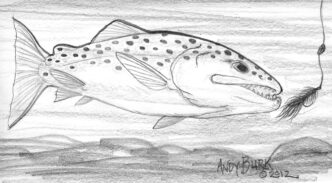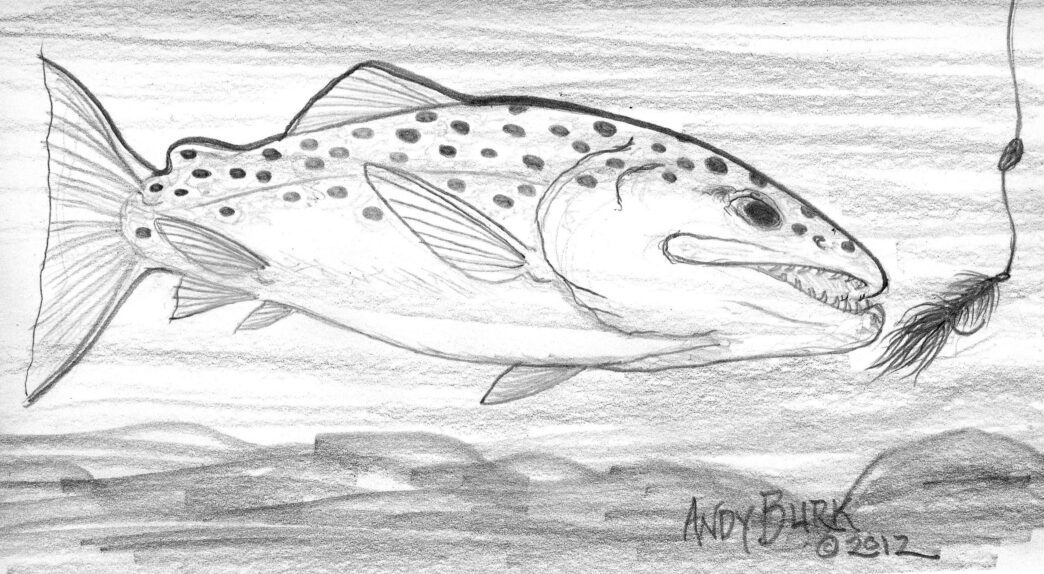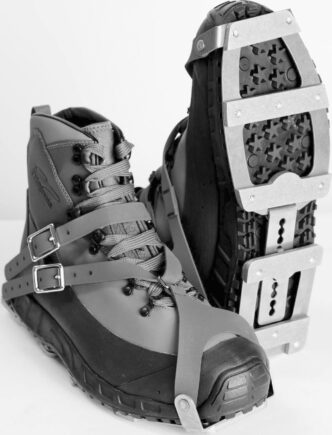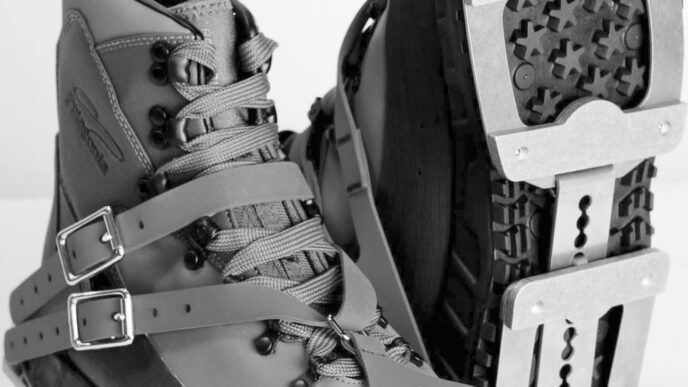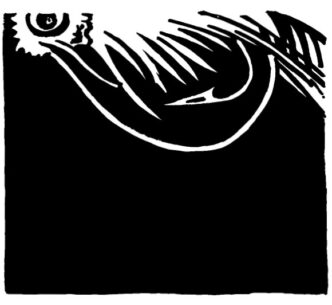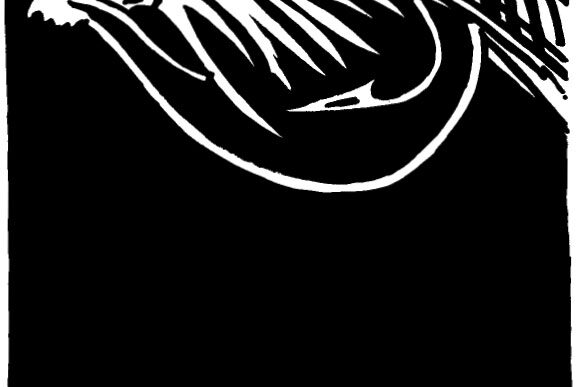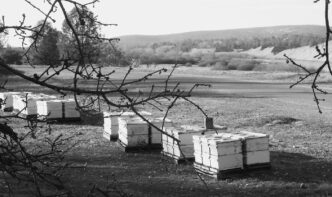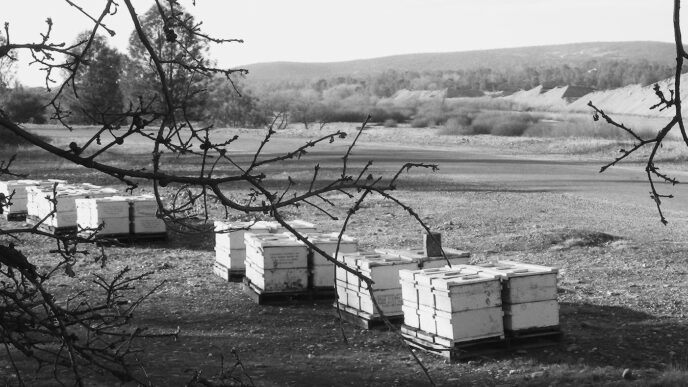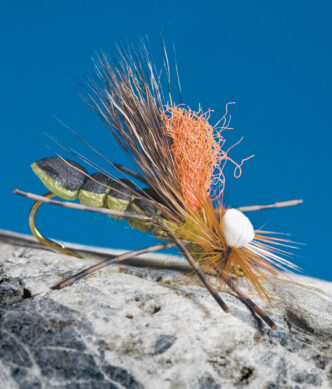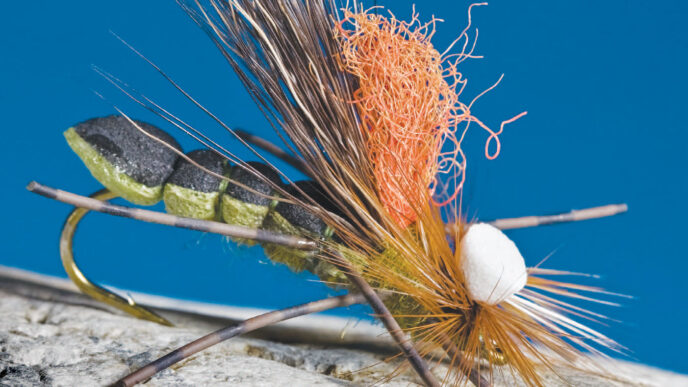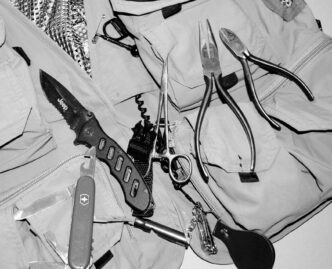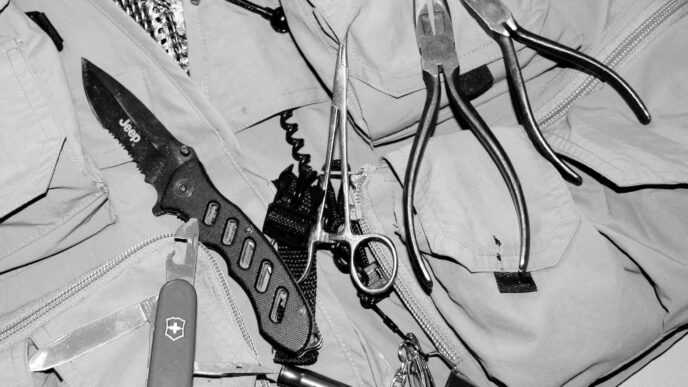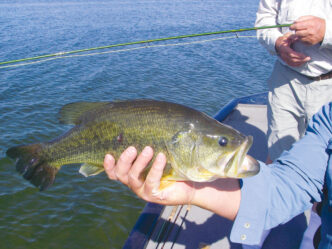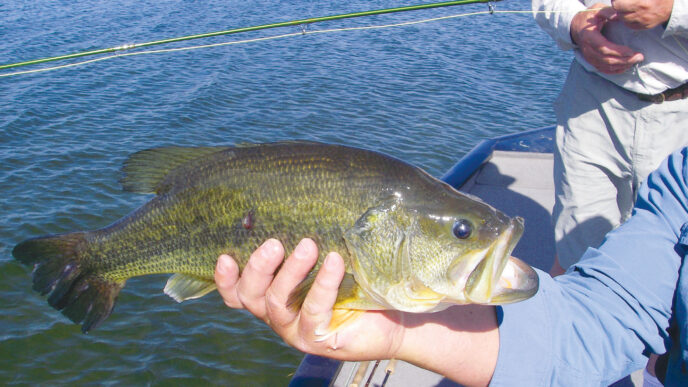The trout was plainly visible, floating just over a little weed patch at the edge of the riffled water, regularly moving slightly to one side or the other to intercept bugs brought to it by the current’s flow. I watched the fish carefully from my crouched position just 12 feet away, using a small clump of grass as a makeshift blind. After studying the fish for a few more minutes, I slowly reached for my rod, which was lying on the grass beside me, and checked the knot on the little midge pupa that was already tied to the 6X tippet. A tiny piece of tungsten putty was rolled onto the tippet 10 inches from the fly to provide weight. I looked carefully at the position of the fish and then prepared to make the all-important first cast.
Keeping the rod at a low angle so as not to wave it through the fish’s window of vision, I made the cast. The tungsten hit the water with a slight splash a foot and a half above the fish’s position. It turned, I set the hook, and soon I had in hand a beautiful native trout, certainly not a very big one, but one that had taken every bit of my skill to fool. It wasn’t that the fish was particularly selective in what it was eating, but it was the first fish that day that I had managed to catch, rather than scare off.
I was fishing on a moderate-sized stream that has a decent-sized population of trout, but isn’t one of the better-known places where I go. I usually visit it when my ego needs a boost after a few tough trips — which was exactly why I had gone there on this day. After a really tough week on the Truckee with very little to show for my efforts, I had decided it was time to head somewhere easier — a place where the trout were not particularly selective or spooky, a place where I could feel the tug of a hooked fish.
What I didn’t expect was that my little go-to ego-booster stream was low and
clear and the fish were as spooky as any that you’d encounter on a big-name spring creek. I was soon employing all of my tricks for fishing low and clear conditions, and I was still spooking trout left and right. I left the stream later that evening having landed a couple of smallish fish and having gained a greater appreciation for small trout and the low and clear environment they often inhabit.
On the drive home I pondered the barrage of difficult angling conditions that confront anglers, from the high and muddy waters of the spring runoff to the low, clear waters of late summer, fall, and winter. The fly fisher must cope with all of these conditions at one time or another.
High and Dirty Water
Probably the most frequent challenging condition that faces the angler is that of high and dirty water. Whether it is caused by springtime runoff, a seasonal
rainstorm, or an unexpected dam release, nothing can test an angler’s mettle like high and dirty water. Often, with high and dirty flows come very cold water temperatures, which can add another level of difficulty to an already tough situation.
When faced with high and dirty water, my initial task is to make an honest assessment of the situation. First off, I check the temperature of the water. If it’s below 40 degrees, I know that things are going to be really difficult. If the water temperature is in the mid-30s, and if I haven’t spent a lot of time and money to get to this stream, I consider looking for another area to fish. If, however, you’re stuck with fishing where you are, do what I do, and try to make the best of it.
When it comes to fishing high and dirty water, the most important thing to do is to find the fish. The key to locating them is figuring out what water will be most comfortable for the fish to stay in while these conditions prevail. I rarely find fish directly in midstream flows or pocket water under these conditions. You’ll find most of the fish in water of moderate depth and slower current flows, normally fairly close to the bank. One thing working in your favor is that when the water is murky, the fish will have very little chance of seeing you as you approach close enough to present a fly.
I like to look for spots that are adjacent to those places where fish are normally found in the stream. If the fish are most often found in riffles and pocket water, I look for areas that are from two to three feet deep and located near the bank. These deep pockets of calmer water in an otherwise high and turbid river become sanctuaries for fish. If the fish are also fond of hanging out in deeper runs and bigger pools, I immediately look to the top of the pool or run, because deep, swirly holes will often be created there during high and dirty conditions. One of my best days fishing high and dirty water occurred in one of these “swirlies” just off the main flow at the top of a very deep pool on the Truckee. Fish were stacked up in this zone, and for a while it seemed as if I was catching one every other cast. Under normal river conditions, this spot is about 10 inches deep and holds no fish over two inches in length.
How to Fish High And Dirty Water
In high and dirty water, once you determine where the fish are, it’s just a matter of figuring out how to catch them. I keep my fly selection and rigging simple. You will have to accept that you’ll lose flies and that leaders will get ruined as a regular part of fishing under these conditions. High water moves around all kinds of stuff in the river, and you’ll frequently snag flies on debris and other hidden underwater obstacles. I usually fish a leader that’s between 7-1/2 and 9 feet long and that tapers down to 3X. I don’t use fluorocarbon anymore. I think it’s not worth the extra cost and environmental impact. The fish do not care in high and dirty water anyway. I prefer to tie a short, 12-inch tippet directly to the end of my tapered leader, because the knot acts as a stopper for my weight, whether I am using split shot or putty.
I generally don’t use an indicator under these conditions, but I occasionally put one on just to increase my ability to detect a strike. The reason for not using an indicator is because the bottoms of the areas you’ll be fishing often are funky, and the depths can be inconsistent. You’ll be fishing in a foot of water on the first part of your drift and in three feet of water at the end. An indicator can sometimes keep your fly from getting to the most productive zones.
Weight is the most important part of the equation, and I use two types — the old, tried-and-true split shot and the newer tungsten putty. I’ve really come to like the putty, because I find it hangs up a little less and I can adjust the weight more quickly than I can with split shot. An added bonus is that you can shape the putty into a streamlined little torpedo that doesn’t hang up as easily as a split shot. As I said, I like to place the weight above a tippet knot and use a short, foot-long tippet. Although I do this mainly so there’s a stopper knot for my weight, the tippet takes a beating in this environment, and it’s easier to replace a foot at a time. If you don’t inspect your tippet frequently, it will get dinged and let you down, and you’ll end up losing a big fish.
The flies to use in high and dirty water are simple. Choose something black in color and bulky in silhouette. The good ol’ Woolly Bugger is one of my favorites for this type of fishing. It’s easy to tie, and I don’t cry when I hang one up on a giant submerged log and have to break it off. It’s worth noting that I rarely, if ever, use a multiple-fly rig in these conditions, because it is a recipe for losing twice as many flies.
As I work my way up to one of the places where fish find refuge in high and dirty water, I take extra care that my footfalls are not too heavy. You may have a major advantage in that the fish won’t be able to see you, but you should also try hard not to let them feel or hear you, either.
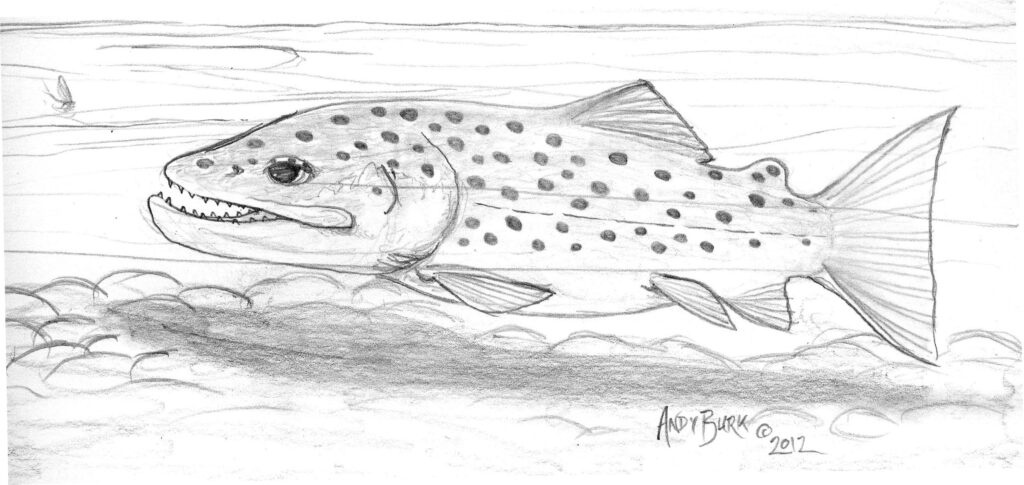
Most of the fish are going to be near the water’s edge, so I make short casts, and I immediately raise the rod and remove slack from the line so that I’m in control of the fly’s drift. It’s not uncommon to have to lead the fly through the water in some of these zones, because the current can move very slowly in these areas — that’s why the fish have taken refuge there, after all.
Once the fly is in the water, I find it best to let it soak. That is, I’m not in any great rush to cast again. The longer the fly is in the zone where the fish are, the better chance you have that a fish will find it. Takes will usually be unmistakable as a sharp tug. Fish do not let food get away under conditions this challenging for them.
After a few days of angling along the banks of a high and muddy river, you’ll get the hang of finding and catching fish when the water is like this. You may not catch as many fish as you would under ideal conditions, but you never know — you may just find the spot and land a couple of big ones.
Low and Clear Water
The low and clear water of the late summer, fall, and winter can be harder to deal with than high and dirty water in the spring. Success depends on your approach to the stream when the water is low and clear and the fish are spooky. You have to be sneaky at all times.
In low, clear water, you’ll find fish in all kinds of places, from deep pools to shallow riffles and pocket water. In particular, you’ll find that fish in low and clear water seek areas that offer overhead cover or shade. Look for spots with overhanging trees and bushes, because fish in these conditions love to keep the bright light out of their eyes and hide from potential predators, such as ospreys, kingfishers, and herons. Once you’ve found a shady spot, you’ve probably found a fishy spot, as well. You can’t go wrong by being extra stealthy when the water is low and clear. It doesn’t matter whether you are on a coastal steelhead river or a tiny creek. I never wear any bright or white-colored clothing when faced with low and clear conditions. Stick to drab tan, brown, gray, and olive to blend with the surroundings. I know plenty of anglers who wear camouflage clothing when they hit the water.
How to Fish Low and Clear Water
Fishing in low and clear conditions has its own challenges, mostly related to the need for stealth. You should approach the fish from a position that allows you to stay out of its window of vision and make a cast. The key is to slow down and look very carefully as you work your way along the stream. Once you have located a target fish or have found a shaded spot that might hold fish, take a few extra moments to study it for the all-important first cast. A well-placed first cast will give you a better than average chance at a hookup.
Low and clear conditions will really test your skills when it comes to casting, and I’ve spooked plenty of fish with a first cast that landed too heavily on the water or didn’t land in the right spot. Don’t get too worked up about wasting a shot here or there due to these little errors — they happen quite frequently when you fish under these conditions, and we learn from our mistakes as we go.
I’ve always used a 5-weight rod for most of my trout fishing, but during the past couple of seasons, I’ve found myself pulling a little 7-1/2-foot 3-weight rod out of the tube. There are several reasons for this. The lighter line doesn’t land nearly as heavily on the water, and I’ve found that it’s a lot easier to sneak around with a shorter rod. I’m also less likely to spook fish with a waving rod or the rod’s shadow on the water. In addition, I’ve found that using a 7-1/2-foot leader allows me to get extremely accurate fly presentations. I typically fish a 5X or 6X tippet in these situations, and as I mentioned before, I’m not particularly enamored of fluorocarbon tippet material. I know many people will tell me that fluorocarbon is the answer, but I always counter that a good presentation is the answer. If I want to get the tip of my fly line a little farther away from the fish, I can always add a few feet of tippet to the end of the shorter leader.
In low and clear conditions, the position of the fish will dictate whether to use an upstream or downstream presentation. If I have a choice in low and clear conditions, I prefer a straight-upstream presentation to the fish. It allows me to present the fly in a way that takes advantage of the fish’s blind spot in its window of vision. I also find I can make a few more presentations to a fish before I either catch it or spook it. With a downstream presentation, it can be very hard to get multiple presentations to a fish, because once the fly has drifted past the fish, you must drag it back upstream past its position before you can cast again. When using a downstream presentation, the first cast is definitely the most important one of all.
Fly selection for low and clear conditions can be one of the toughest things of all to figure out. Dry flies are by far my favorites, because they don’t hang up on the bottom and, most importantly, they don’t plop down too heavily on the water’s surface. I rely heavily on parachute-style patterns for low and clear conditions because they land lightly on the water and offer a very clean silhouette to the fish. I try to match my flies to insects that are prevalent on the water, so all my normal mayfly, caddis, and terrestrial patterns are in play. If it’s the height of summer, smaller hopper, beetle, and ant patterns can be a great choice. I also like having along a few Royal Wulffs and Humpies, size 18 to 22. Scaled-down attractor patterns often work wonders.
Nymph fishing under low and clear conditions can be very challenging, and I find there are two major mistakes that many folks make when gearing up to fish subsurface flies in these conditions. The first is that they tend to use their normal nymph-and-indicator rigging, which lands like a flopping squirrel in these conditions. A Humpy or other high-floating attractor is a much better choice for use as an indicator in low and clear water, and it will occasionally catch a fish or two, as well. I normally tie on a size 14 or 16 dry as my indicator fly. If conditions allow, I prefer to go without the indicator fly, though, and rely on the movement of the fish or the twitch of my leader to tell me if a fish has taken the fly.
You’ll need to pick your nymphs carefully when fishing low and clear water. I rarely fish beadhead nymphs under these conditions. They typically sink too fast and land too hard, in addition to being a little too bright and flashy for spooky fish. A small Hunchback Infrequens, Hare’s Ear, or Bird’s Nest without a bead is a really solid choice in these situations and will catch fish for you most of the time. If I need a fly that sinks a little more quickly, I add a tiny piece of tungsten putty molded onto the leader about 10 inches from the fly. It doesn’t take much to sink a fly to the level of the fish.
Fishing under low and clear conditions is a constant challenge, but with what you now know, I’m sure you’ll be up to it. Just remember to move slowly and to strive for perfect presentations, especially on the all-important first cast.
Coping with tough conditions, whether the water is high and dirty or low and clear, will make you a better angler. The next time you’re faced with these situations, approach with care and confidence, and you’ll find that the number of fish you catch under “normal” conditions increases tremendously.



